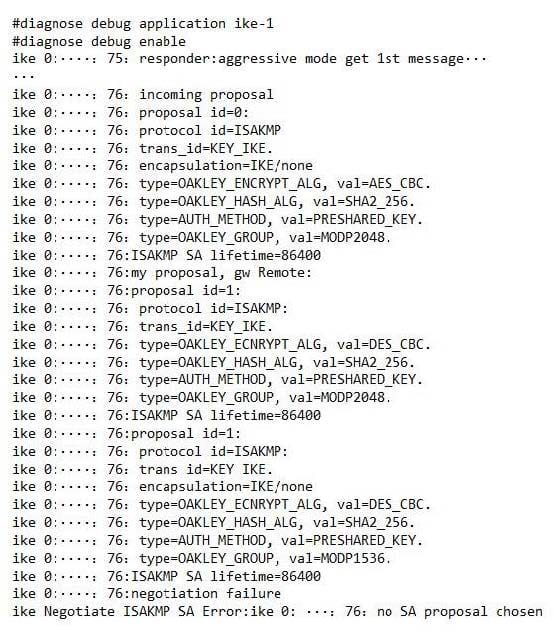NSE7_EFW Online Practice Questions and Answers
Questions 4
In which of the following states is a given session categorized as ephemeral? (Choose two.)
A. A TCP session waiting to complete the three-way handshake.
B. A TCP session waiting for FIN ACK.
C. A UDP session with packets sent and received.
D. A UDP session with only one packet received.
Questions 5
Which of the following tasks are automated using the Install Wizard on FortiManager? (Choose two.)
A. Preview pending configuration changes for managed devices.
B. Add devices to FortiManager.
C. Import policy packages from managed devices.
D. Install configuration changes to managed devices.
E. Import interface mappings from managed devices.
Questions 6
Examine the partial output from the IKE real time debug shown in the exhibit; then answer the question below.

Why didn't the tunnel come up?
A. IKE mode configuration is not enabled in the remote IPsec gateway.
B. The remote gateway's Phase-2 configuration does not match the local gateway's phase-2 configuration.
C. The remote gateway's Phase-1 configuration does not match the local gateway's phase-1 configuration.
D. One IPsec gateway is using main mode, while the other IPsec gateway is using aggressive mode.
Questions 7
Which of the following statements are true regarding the SIP session helper and the SIP application layer gateway (ALG)? (Choose three.)
A. SIP session helper runs in the kernel; SIP ALG runs as a user space process.
B. SIP ALG supports SIP HA failover; SIP helper does not.
C. SIP ALG supports SIP over IPv6; SIP helper does not.
D. SIP ALG can create expected sessions for media traffic; SIP helper does not.
E. SIP helper supports SIP over TCP and UDP; SIP ALG supports only SIP over UDP.
Questions 8
Examine the following traffic log; then answer the question below.
date-20xx-02-01 time=19:52:01 devname=master device_id="xxxxxxx" log_id=0100020007 type=event subtype=system pri critical vd=root service=kemel status=failure msg="NAT port is exhausted." What does the log mean?
A. There is not enough available memory in the system to create a new entry in the NAT port table.
B. The limit for the maximum number of simultaneous sessions sharing the same NAT port has been reached.
C. FortiGate does not have any available NAT port for a new connection.
D. The limit for the maximum number of entries in the NAT port table has been reached.
Questions 9
A FortiGate device has the following LDAP configuration:

The administrator executed the `dsquery' command in the Windows LDAp server 10.0.1.10, and got the
following output:
>dsquery user -samid administrator
"CN=Administrator, CN=Users, DC=trainingAD, DC=training, DC=lab"
Based on the output, what FortiGate LDAP setting is configured incorrectly?
A. cnid.
B. username.
C. password.
D. dn.
Questions 10
When does a RADIUS server send an Access-Challenge packet?
A. The server does not have the user credentials yet.
B. The server requires more information from the user, such as the token code for two-factor authentication.
C. The user credentials are wrong.
D. The user account is not found in the server.
Questions 11
An administrator has decreased all the TCP session timers to optimize the FortiGate memory usage. However, after the changes, one network application started to have problems. During the troubleshooting, the administrator noticed that the FortiGate deletes the sessions after the clients send the SYN packets, and before the arrival of the SYN/ACKs. When the SYN/ACK packets arrive to the FortiGate, the unit has already deleted the respective sessions. Which TCP session timer must be increased to fix this problem?
A. TCP half open.
B. TCP half close.
C. TCP time wait.
D. TCP session time to live.
Questions 12
Which of the following statements are correct regarding application layer test commands? (Choose two.)
A. They are used to filter real-time debugs.
B. They display real-time application debugs.
C. Some of them display statistics and configuration information about a feature or process.
D. Some of them can be used to restart an application.
Questions 13
An administrator is running the following sniffer in a FortiGate:
diagnose sniffer packet any "host 10.0.2.10" 2
What information is included in the output of the sniffer? (Choose two.)
A. Ethernet headers.
B. IP payload.
C. IP headers.
D. Port names.
